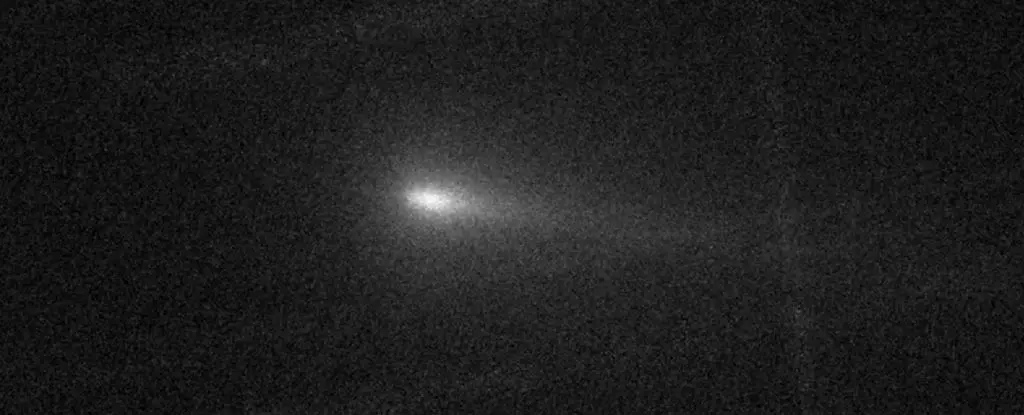Comets have long fascinated humanity, capturing imaginations and igniting curiosity about our universe. Recent observations of Comet C/2024 S1, anticipated to be a brilliant spectacle in the night sky as Halloween approached, have instead revealed a rather disappointing narrative. This Kreutz sungrazer comet, which was discovered on September 27, is undergoing disintegration as it nears its closest approach to the Sun, predicted to occur on October 28, 2024. This cosmic event provides a compelling case study on the lifecycle of comets and the dynamics at play within our solar system.
Comet C/2024 S1 was set to make a close pass of about 1.2 million kilometers (approximately 750,000 miles) from the Sun, generating excitement among astronomers and skywatchers alike. However, a flurry of images captured during October depicted a different narrative: an object that initially brightened due to outburst activity began to fade, with its nucleus seemingly vanishing. Observers noted an emerging tail of gas and dust, which speaks to the processes involved in comet disintegration.
The dynamics inherent in comet activity typically involve significant changes as these celestial objects approach the Sun. Specifically, the increase in temperature can lead to sublimation, a process where solid materials convert directly into gas, causing instability within a comet’s structure. This inherent fragility means that disintegration is a fate not uncommon to such objects, and in the case of C/2024 S1, conditions appear ripe for a clearer understanding of this phenomenon.
The potential disintegration of a comet comes down to its composition and structure. Comets are often composed of various ices and rocky materials, making them relatively fragile, especially when faced with the Sun’s intense heat. As temperatures rise, sublimation occurs—ice converts to gas, which can create pressure pockets within the nucleus. When these forces exceed the structural integrity of the comet, fragmentation can happen rapidly.
In October, observations indicated that C/2024 S1 experienced at least one noticeable outburst, leading to brightening. Such events are characterized by sudden ejections of dust and gas that temporarily increase a comet’s visibility. However, they can also be critical indicators of the structural degradation of a comet’s nucleus, presaging potential disintegration.
Research and historical verification, such as that of Comet C/2019 Y4 in 2020, offer context to understanding the complexities of these behaviors. The shattering of that comet while close to the Sun is a poignant reminder that even the most promising celestial bodies can falter under solar intensity.
The story of C/2024 S1 is also intertwined with its heritage as a fragment of a larger entity. Kreutz sungrazers are understood to be remnants of a catastrophic breakup of the Great Comet of 1106 CE, linking contemporary observations to historical phenomena. The larger momentum behind such fragmentation events offers insight into evolutionary patterns of comets throughout time, showcasing how cosmic remnants can yield new celestial visitors to our skies.
As C/2024 S1 continues its journey toward perihelion, its brightness potential appears compromised. While initial projections suggested it might rival Venus in brightness or even be visible during daylight, such expectations may need readjustment. However, the excitement isn’t entirely dimmed; even a fragmented nucleus could provide dramatic views of a curving tail of debris, trailing where the nucleus once shone brightly.
So far, C/2024 S1 may still be within reach for astronomers equipped with binoculars or small telescopes, particularly from the Southern Hemisphere. As we approach perihelion, conditions may still allow for viewing a comet, albeit without the brilliant head typically associated with these cosmic wanderers.
For enthusiasts in the Northern Hemisphere, a glimpse of this celestial journey may still be possible post-perihelion, depending on the survival of fragments through this harrowing process. The search for how C/2024 S1 ultimately behaves underscores the thrill of astronomical observation—the blend of science and wonder that captivates skywatchers across the globe.
As we continue to monitor C/2024 S1, one truth remains: the cosmos is replete with fleeting moments of beauty, intrigue, and surprise. Whether we witness a splendid display or a long, luminous tail, the narratives woven from our observations are just as valuable as the celestial marvels themselves. Happy hunting for those who gaze upon the night sky, ever curious of what it holds.

